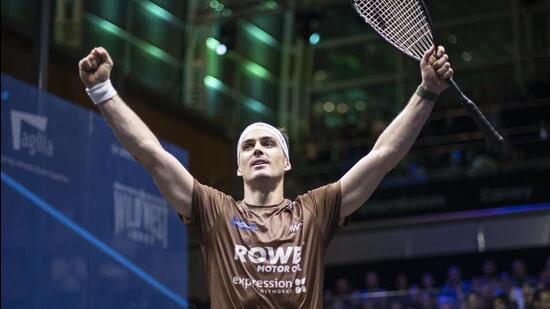Mumbai: From 2013 to 2016, through his early- and mid-twenties, New Zealand squash star Paul Coll floated between the world ranking of 100 and 25. It’s a space India’s current top pros find themselves in, hoping to kick on to the next level.
Nicknamed “Superman” for his on-court athleticism, Coll soared to that level and continued to fly high.
Since 2017 when he broke into the top 10, Coll has been a constant among squash’s elite. In that period, he became the world No.1 in 2022, won four World Championships and two Commonwealth Games medals, including the 2022 gold beating Saurav Ghosal in the semi-final. Now ranked 4th, the 33-year-old is chasing more glory at the ongoing Worlds in Chicago.
Indian squash hasn’t yet seen a pro go from 25 to 5 in the rankings; the closest to that came Ghosal, Joshna Chinappa and Dipika Pallikal (all former world No.10s). Coll did that by moving out of his comfort zone, in terms of coaching and training for modern squash that, according to him, is evolving “in a high-paced direction”.
“I always moved around and looked for people that could offer the skills that I needed to improve,” Coll told HT. “I was very aware of my weaknesses, and always set out to improve those as much as maintain what I was super strong in. I think some players don’t really look at their weaknesses as much and don’t do the things that they don’t like to do. They then get sort of stuck at a certain ranking.”
Growing up in New Zealand, Coll wasn’t among the top juniors. He moved his training base to the Netherlands and worked with different coaches over the years. It helped shake things up when he felt like he was plateauing.
“Certain coaches can offer certain things for you, and then maybe you outgrow the coach. It’s about getting outside your comfort zone. People stay in their comfort zone, do what they like to do, and that’s why they plateau. I was good at looking for new people that would help me improve my game. It’s not a comfortable thing, but it certainly helped me,” he said.
He also wouldn’t get too comfortable in his training methods for a sport that Coll believes has become a lot more physical. “Everyone’s got fitter, the game’s become faster, there’s a lot more pace, a lot more contact,” he said. “With sports science now, people are training in a different way.”
For example, Coll now wears heart rate straps and GPS devices to track how much he moves on court during a match. “So, you can train in the same zones (in terms of heart rates and movement) to what you’re playing,” he said.
Things like that have made training for modern squash more scientific and data driven. It’s a prerequisite for pros now.
“There’s no point just guessing what you need to do,” Coll said. “With the technology out there, a lot of players are taking advantage and seeing what zone they play in. The amount of load that it takes of you to win a tournament; you try and do that in your training weeks as well. Managing the energy throughout a long season, so that you’re not having those dips, is also key. It’s a hard sport to train for a whole season, but using that scientific data helps you through it and get more professional and consistent throughout the season.”
In a 2017 video where the Professional Squash Association shadowed Coll on a training day, he began with an early morning stretching session, followed by exhaustive weight training at the gym, dry needling physio work, and an on-court ghosting block to wrap up the evening.
That’s how an average training day still largely looks like for Coll during the season, depending on the tournament schedule. It ramps up in the off season in July-August.
“It becomes a lot hotter and higher in intensity and durations, where I can set my body up for the season,” he said. “So, a lot of running, a lot heavy weights, for six days a week. There are longer squash sessions in the morning, and harder physical sessions in the afternoon.”
Gym work and weight training is “hugely important” for today’s squash of gruelling physicality.
“If you don’t do gym work and weights, you’re asking for injuries in squash. It’s a sport that requires every aspect of fitness – speed, endurance, strength, flexibility. If you’re not covering all those bases, you’re putting yourself at a higher risk for more injuries,” he said.
That’s another challenge a lot of Indian squash pros face as they push for a harder climb up the ladder. The depth of Indian squash, though, impresses the world No.4.
“There’s a good number of Indian players on the tour, which is great to see. India tend to be very strong in the team events, because they have quite a good depth of players who are always quite skillful,” Coll said.
The key, though, will be to get out of the comfort zone.
